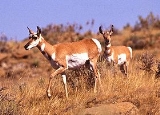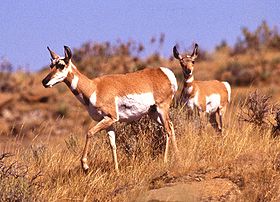
Fort Keogh
Encyclopedia

Miles City, Montana
Miles City is a city in and the county seat of Custer County, Montana, United States. The population was 8,123 at the 2010 census.- History :...
. Occasionally spelled Fort Keough. Originally a military post, today it is a United States
United States
The United States of America is a federal constitutional republic comprising fifty states and a federal district...
Department of Agriculture livestock and range research station. It is listed on the National Register of Historic Places
National Register of Historic Places
The National Register of Historic Places is the United States government's official list of districts, sites, buildings, structures, and objects deemed worthy of preservation...
. The development of Fort Keogh as a military installation soon stimulated traders to supply the liquor and other service businesses that were the beginning of Miles City.
The need for a military fort
Shortly after the defeat of General George Armstrong CusterGeorge Armstrong Custer
George Armstrong Custer was a United States Army officer and cavalry commander in the American Civil War and the Indian Wars. Raised in Michigan and Ohio, Custer was admitted to West Point in 1858, where he graduated last in his class...
at the Battle of the Little Bighorn
Battle of the Little Bighorn
The Battle of the Little Bighorn, also known as Custer's Last Stand and, by the Indians involved, as the Battle of the Greasy Grass, was an armed engagement between combined forces of Lakota, Northern Cheyenne and Arapaho people against the 7th Cavalry Regiment of the United States Army...
on June 25, 1876, the Army sent General Nelson A. Miles
Nelson A. Miles
Nelson Appleton Miles was a United States soldier who served in the American Civil War, Indian Wars, and the Spanish-American War.-Early life:Miles was born in Westminster, Massachusetts, on his family's farm...
to the plains of Eastern Montana
Eastern Montana
Eastern Montana is a loosely-defined region of Montana. Some definitions are more or less inclusive than others, ranging from the most inclusive, which would include the entire part of the state east of the eastern front of the Rocky Mountains...
to establish a military fort. The order for development of the fort was signed on August 28, 1876. The Army intended to use its garrison at the post was to reduce warfare by the American Indians in the region and to persuade them to resettle on reservations.
Colonel D.S. Stanley had originally scouted the first site of the fort when he was leading a military expedition though the area. He thought the location would be good for supplying troops throughout the region. But, the Army did not decide to build the fort until after Custer's overwhelming defeat at the Battle of the Little Bighorn
Battle of the Little Bighorn
The Battle of the Little Bighorn, also known as Custer's Last Stand and, by the Indians involved, as the Battle of the Greasy Grass, was an armed engagement between combined forces of Lakota, Northern Cheyenne and Arapaho people against the 7th Cavalry Regiment of the United States Army...
.
As the US and developers planned to bring the Great Northern Railway to the region, the US Army was assigned to survey the land and develop maps. The troops came into contact with two tribes of Indians, the Lakota (Sioux) and the Crow
Crow
Crows form the genus Corvus in the family Corvidae. Ranging in size from the relatively small pigeon-size jackdaws to the Common Raven of the Holarctic region and Thick-billed Raven of the highlands of Ethiopia, the 40 or so members of this genus occur on all temperate continents and several...
. The Sioux had pushed the Crow west of their traditional lands as they moved west, in response to European-American settlers encroaching on Sioux territory. Resentful of the Sioux, the Crow frequently allied with the Army and served as scouts to its expeditions.
General Miles established the "Cantonment Tongue River" at the confluence
Confluence
Confluence, in geography, describes the meeting of two or more bodies of water.Confluence may also refer to:* Confluence , a property of term rewriting systems...
of the north-flowing Tongue River
Tongue River (Montana)
The Tongue River is a tributary of the Yellowstone River, approximately 265 mi long, in the U.S. states of Wyoming and Montana. The Tongue rises in Wyoming in the Big Horn Mountains, flows through northern Wyoming and southeastern Montana and empties into the Yellowstone River at Miles City,...
and the east-flowing Yellowstone River
Yellowstone River
The Yellowstone River is a tributary of the Missouri River, approximately long, in the western United States. Considered the principal tributary of the upper Missouri, the river and its tributaries drain a wide area stretching from the Rocky Mountains in the vicinity of the Yellowstone National...
. The site would provide easy access to boats bringing supplies up the Yellowstone. The original cantonment was referred to by several names during its first two years before the Army officially named it Fort Keogh on November 8, 1878.
Miles was a well-respected as a leader, not only by his troops, but among the Indians as well. Promising fair treatment and better lives to the Native Americans, Miles gradually persuaded the Indian nations to settle on the reservations. Not all the nations surrendered immediately. Miles went to battle against the holdouts with his troops, including during the extreme cold of winter. The Sioux and Crow bands migrated through wide areas in the Montana Territory, and troops were engaged in battle with them hundreds of miles from the fort.
Honoring a fallen soldier
The fort was named for Myles KeoghMyles Keogh
Myles Walter Keogh was an Irishman who fought in Italy during the 1860 Papal War before volunteering for the Union side in the American Civil War . During the war years, he was promoted from the rank of Captain to that of Major, finally being awarded the brevet rank of Lieutenant Colonel...
, an adjutant of General Custer. He also had been killed in the Battle of the Little Bighorn. Born in Ireland on March 25, 1840, Keogh came from a comfortable background. Wanting adventure, Keogh left the farming to a brother and went off to war. In 1860 he went to Italy after the Pope recruited Irish men to take up the fight to save the Papal States
Papal States
The Papal State, State of the Church, or Pontifical States were among the major historical states of Italy from roughly the 6th century until the Italian peninsula was unified in 1861 by the Kingdom of Piedmont-Sardinia .The Papal States comprised territories under...
. In those battles, he won two medals. Later Keogh joined the Papal Guard in Rome.
Keogh preferred warfare to acting as a guard; he resigned his post, and in March 1862 headed to the United States to enter the American Civil War
American Civil War
The American Civil War was a civil war fought in the United States of America. In response to the election of Abraham Lincoln as President of the United States, 11 southern slave states declared their secession from the United States and formed the Confederate States of America ; the other 25...
. He was commissioned as a Captain in the Union Army
Union Army
The Union Army was the land force that fought for the Union during the American Civil War. It was also known as the Federal Army, the U.S. Army, the Northern Army and the National Army...
, and proved his ability repeatedly. He won many commendations, and his bravery in the Battle of Gettysburg
Battle of Gettysburg
The Battle of Gettysburg , was fought July 1–3, 1863, in and around the town of Gettysburg, Pennsylvania. The battle with the largest number of casualties in the American Civil War, it is often described as the war's turning point. Union Maj. Gen. George Gordon Meade's Army of the Potomac...
earned him the rank of brevet Major. Keogh took an assignment in the western wars in 1863; he served under Custer until his death in battle.
Keogh stood his ground, with the company he commanded around him; they were surrounded and outnumbered by Sioux warriors. His body was later found in the center of those of his soldiers. The Army later found his horse "Comanche" walking riderless on the battlefield. Soldiers nursed the horse to health, and he became a legend.
Town development
The arrival of the Army generated a demand for businesses among enterprising traders. Named after the fort's commander, Milestown developed first as an army town to meet the needs of young, isolated men.The Miles City Chamber of Commerce web site noted: "According to the diaries kept by George Miles, the nephew of the Colonel who traveled with his uncle, a man named Mat Carrol set up some barrels under a tarp and started selling whiskey. When Colonel Miles got tired of having his guard house filled to overflowing--whiskey causing him, Miles said, more trouble than the Indians--he ordered Carrol and the other purveyors of liquor to leave the military reservation.
"An employee of Carrol's, one John Carter, rode east on his big bay horse until he was the required two miles (3 km) away, beyond the edge of the reservation. He found a flat spot along the Yellowstone, built a crude log hut out of driftwood and started selling whiskey. The soldiers soon found the place, other merchants followed, and Miles City was born."
Milestown was at first almost nothing but rowdy; many a drunken soldier emerged from its saloons. About a year after settling in the area, General Miles moved the fort to the present location just a couple of miles southwest of the original site. He hoped that the extra distance from the town would slow the unruliness. The town picked up and moved to its current location closer to the fort.
In his book Recollections of Old Milestown,Samuel Gordon notes a frontier confrontation. Riverside Park, which still stands today, was rumored to be up for the taking. The "Old West" rule was that if a man were to get four logs placed on the ground in a square, he had the foundation of a building, and could claim the land as his. One such squatter had placed two of the needed logs, and went to get the other two. A second man saw the two logs, and an opportunity. He placed his two logs with the two currently on site, and stood his ground there. He expected the first man to object and leave. The first squatter was dismissed by the second squatter with, "two logs counted nothing". But the first man pulled out his revolver to settle the dispute. The second man quickly abandoned his claim to the area. Late in the afternoon, tales of the incident reached the fort. Soldiers came out and sent away all the squatters in the area.
Further reading
- Barnes, Jeff. Forts of the Northern Plains: Guide to Historic Military Posts of the Plains Indian Wars. Mechanicsburg, PA: Stackpole Books, 2008.
External links
- The Fort Keogh Papers at the University of Montana, archival guide details miscellaneous correspondence and other materials from Fort Keogh, 1878-1892.
- "USDA Livestock and Range Research Laboratory", Official Webpage, Agricultural Research Service

